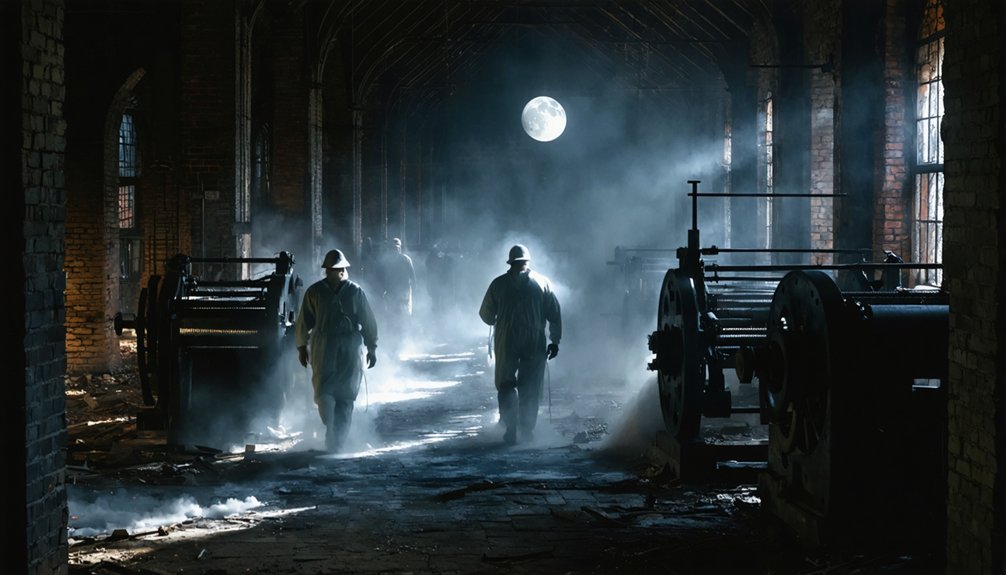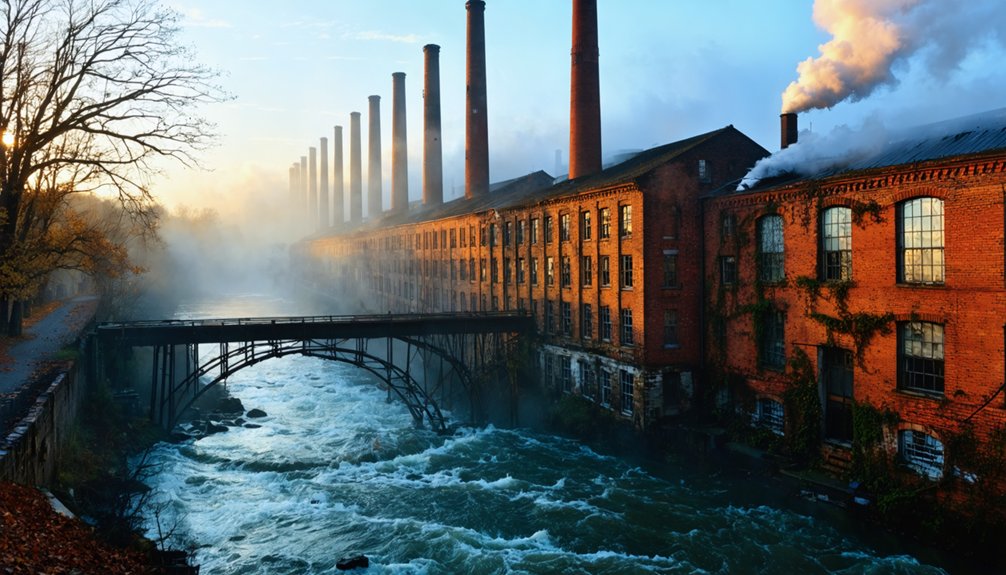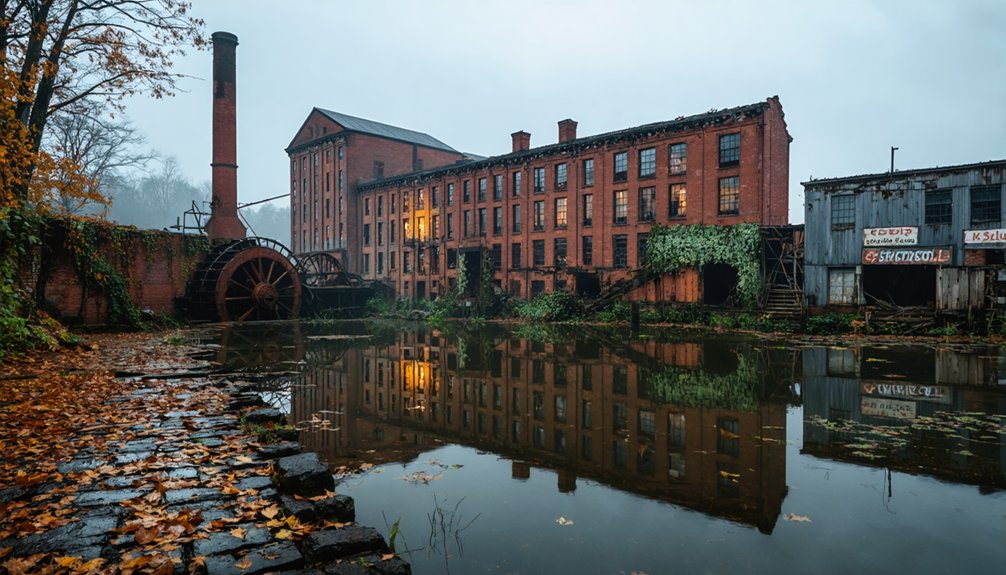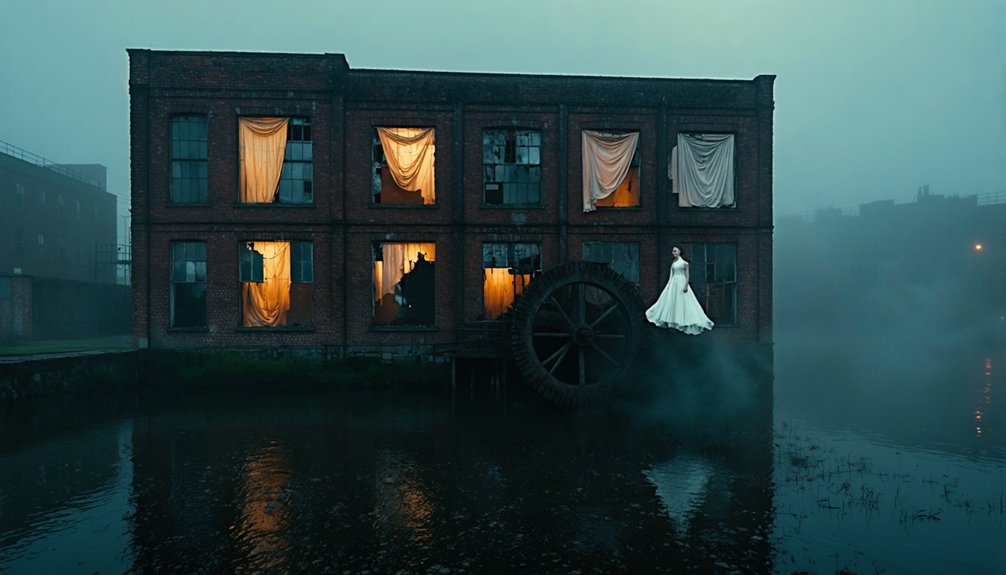America’s mill towns harbor spectral remnants of industrial history. You’ll encounter ghostly apparitions at Falk’s Elk River Mill, whispers in Henry River’s abandoned cottages, and shadowy figures at Chapel Mill. Explore Paterson’s Great Falls where tragic accidents echo, or White Mountain’s eerie cellar holes. In decaying worker quarters of Segundo and Gary, phantom looms still clack at midnight. These haunted ruins reveal the human cost behind America’s manufacturing legacy.
Key Takeaways
- Falk’s Elk River Mill visitors report ghostly apparitions of Thomas, a young worker who died tragically during its 1884-1937 operation.
- Henry River Mill Village, featured in “The Hunger Games,” harbors spectral whispers and shadowy figures in abandoned worker cottages.
- Phantom looms clack after hours at Slater Mill, while spectral workers in period clothing appear at Boott Cotton Mills Museum.
- Paterson’s Great Falls combines industrial heritage with reports of ghostly sightings related to workers who perished in factory accidents.
- Chapel Mill, once a grist mill and casket wood cutting site, attracts paranormal investigators who document shadowy figures and unexplained whispers.
The Echoing Silence of Falk’s Abandoned Mill Machinery
Three ghostly remnants still haunt the landscape where Falk’s Elk River Mill once thrived, a tribute to the industrial ingenuity that powered this logging community from 1884 until its closure in 1937.
If you listen carefully, you’ll hear industrial echoes of the original Falk locomotive and bandsaw—America’s first—that once transformed redwood giants into lumber.
Though Sierra Pacific demolished most structures in 1979, the relocated engine house serves as a memorial to the innovative machinery that couldn’t survive the Depression’s economic pressures. The mill’s impressive capability to produce 40,000 board feet of lumber daily by 1907 stands as a testament to its former industrial might.
Visitors often report ghostly apparitions near the old loading docks, particularly of Thomas, a young worker killed in a tragic accident. Many visitors feel a strange connection to him, similar to how Sarah seemed to connect with the ghost during her encounter at the old mill.
The eerie silence now permeating the site where steam donkeys replaced oxen and locomotives hauled logs seems to amplify these supernatural encounters.
White Mountain’s Decaying Cellar Holes: Doorways to the Past
As you wander through the dense forests of White Mountain National Forest today, rectangular depressions in the earth mark doorways to a forgotten era—cellar holes where families once built lives in thriving mill communities like Thornton Gore and Peeling.
These stone-lined foundations, abandoned by the early 1900s, tell stories that maps often miss. During cellar exploration, you’ll find remnants of chimneys, crumbling steps, and nearby stone walls marking boundaries of long-vanished farms. The Ranger Trail area alone contains five cellar holes indicating a small 19th-century community that once existed there.
Hidden doorways to history, these forgotten foundations offer glimpses into lives etched in stone a century past.
Many visitors report ghostly connections at these sites—eerie sensations that intensify during storms or nightfall. These spectral encounters bridge past and present, connecting you to the hardships and hopes of mountain settlers.
These sunken rectangles, slowly reclaimed by forest, represent more than ruins—they’re portals where history’s whispers can still be heard if you’re willing to listen. These sites reflect the significant economic transition that forced many New Hampshire farmers to abandon their homesteads as industrialization drew people to urban centers.
Whispers Among Henry River’s Vacant Worker Cottages
Walking the worn paths between Henry River Mill Village‘s abandoned worker cottages today, you’ll find yourself surrounded by ghostly echoes of North Carolina’s textile past.
Built around 1905, these 35 modest homes once housed mill workers who endured life without running water or indoor plumbing.
After the mill burned in 1977, decline accelerated. Families gradually departed until the early 2000s, leaving the wooden structures to decay – collapsing porches and broken windows now frame emptiness.
Modern visitors might recognize this haunting landscape as District 12 from the blockbuster film “The Hunger Games,” which used the abandoned village as a filming location.
Locals speak of ghostly whispers carried on evening breezes and spectral sightings in period attire appearing in cottage windows after dusk. Cold spots, unexplained noises, and shadowy figures add to the village’s eerie reputation.
Since 2017, Calvin Reyes and his family have purchased the property with aspirations to restore it to its former glory while preserving its historical significance.
Now on the National Register of Historic Places, these cottages preserve both architectural history and the intangible remnants of those who once called this company town home.
Chapel Mill’s Haunted Grist Operations: Grinding to a Ghostly Halt
Deep in Lamar County, Georgia, Chapel Mill stands as a weathered monument to nineteenth-century ingenuity. Built in the 1830s, this two-story wooden structure once buzzed with activity as farmers brought their grain to be ground while casket wood was cut in an adjacent section—a combination that planted seeds for its haunted history.
You’ll feel a chill as you approach the abandoned ruins where ghostly encounters are commonplace. Similar to the Benson Grist Mill in Utah, the site attracts both history enthusiasts and paranormal investigators. Visitors report shadowy figures moving between what remains of the mill and scattered remnants of the once-thriving community.
At night, unexplained whispers echo through the structure, compelling you to glance over your shoulder. The mill’s reputation for safety once assured locals it was as safe as flour in its operational heyday.
Though now preserved only by dedicated locals and its reputation for paranormal activity, Chapel Mill continues to grind memories rather than grain, attracting those seeking both historical significance and supernatural experiences.
Paterson’s Great Falls: Where Industrial Dreams Became Nightmares
When you stand at Paterson’s Great Falls today, you’re witnessing the same 77-foot cascade that powered Alexander Hamilton’s ambitious vision for America’s first planned industrial city in 1792.
You’ll feel the mist from waters that once drove cotton mills, locomotive works, and silk factories where thousands toiled in harsh conditions that sparked landmark labor strikes.
The thundering falls that brought technological innovation and manufacturing wealth also witnessed countless industrial accidents, creating a haunting juxtaposition between economic progress and human suffering that still echoes through the historic district.
The park, which was officially established as Paterson Great Falls National Historical Park in 2011, preserves the industrial heritage that shaped American manufacturing for generations.
The area now attracts nearly 300,000 visitors annually who come to experience both the natural beauty and complex industrial legacy of this historically significant site.
Hamilton’s Haunted Vision
Though Alexander Hamilton‘s visionary eyes first beheld the thundering Great Falls of the Passaic River during the Revolutionary War, he couldn’t foresee how his industrial dream would evolve into a complex legacy of both triumph and suffering.
When you walk along the 77-foot cascades today, you’re tracing Hamilton’s vision for American economic independence. His Society for Useful Manufactures established Paterson in 1792 as America’s first planned industrial city, harnessing water power through an ingenious raceway system.
While this industrial legacy birthed diverse manufacturing—from cotton mills to Colt revolvers to locomotives—it also spawned exploitation.
Workers fought back against crushing conditions: children laboring 13½ hours daily, six-month strikes for eight-hour days. These ghosts of labor struggles still echo at the falls where Hamilton’s dream of freedom ironically created new forms of bondage.
Falls’ Deadly Power
Behind the inspiring cascade of Paterson’s Great Falls lurked a deadly force that claimed countless lives throughout its industrial heyday. You can almost hear the echoes of tragedy in the rushing waters that once powered the nation’s first industrial city.
The haunted machinery that drove America’s manufacturing revolution extracted a terrible human cost. Water-powered mill equipment mangled workers in spectral accidents that became all too common.
As you walk these grounds today, imagine the overcrowded textile mills where laborers toiled amid constant danger.
The waters that fueled Paterson’s economic might also carried away industrial waste, poisoning the Passaic River. Even as the falls powered America’s locomotives, silk looms, and firearms, they simultaneously powered an undercurrent of human suffering.
The Vanished Communities: When Company Towns Became No One’s Town
If you’d wandered through any of the 2,500 once-thriving company towns after their industries collapsed, you’d have witnessed the haunting transformation of bustling workers’ quarters into silent, crumbling shells.
Where paydays once brought life to company-built homes and communal spaces, economic devastation swept through with alarming speed, leaving behind peeling paint, sagging porches, and overgrown pathways.
The abandoned dormitories and family cottages—their rotting timbers and broken windows still holding echoes of mill whistles and children’s voices—now stand as decaying monuments to America’s industrial boom-and-bust cycle.
Sudden Economic Collapse
When the final whistle blew at the mill for the last time, it signaled more than the end of a shift—it marked the death knell for entire communities built around single industries.
You could watch the economic collapse unfold like a slow-motion tragedy—Gary’s coal production plummeting 28% in just five years, with 38% of workers suddenly finding themselves without purpose.
These company towns, tethered to the fate of a single employer, had nowhere to turn when globalization and deindustrialization swept through America.
The massive job loss triggered exodus—Gary dwindled from a bustling city to just 772 souls by 2020.
Those who remained faced the burden of abandoned infrastructure, environmental hazards, and the crushing weight of community disintegration.
The rusted machinery and empty storefronts stand as monuments to prosperity that vanished overnight.
Decaying Workers’ Quarters
Today, you’d barely recognize the identical rows of workers’ quarters that once housed thousands of mining and mill families across America’s industrial heartland.
These cheaply constructed homes—built identically to minimize costs—now stand as decaying architecture along creek valleys and between mountains.
Where bustling communities once thrived, places like Segundo, Colorado and Gary, Indiana have transformed into ghost towns.
Workers’ memories linger in abandoned duplexes where racial segregation deliberately separated Black, immigrant, and white families into distinct neighborhoods with dramatically different amenities.
The physical remnants tell stories of company control—towns where everything from the store to the church was company-owned.
After mass exodus in the 1960s, these isolated communities sit eerily empty, with fewer than one-third of former residents remaining in places like McDowell County.
Midnight Footsteps: The Spectral Shift Workers of America’s Mill Ruins

Across the skeletal remains of America’s once-thriving mill towns, nightfall brings more than just darkness—it summons the ethereal footfalls of those who once toiled within these industrial giants.
You’ll hear phantom looms clacking in Slater Mill long after closing time, while at Boott Cotton Mills Museum, spectral workers in period clothing wander corridors they once knew intimately.
- Shadowy figures drift between rusting machinery in Coleridge Mill, North Carolina, their forms visible only from the corner of your eye.
- Burlington Mill’s ghostly girl eternally works her loom, a haunting reminder of child labor’s dark legacy.
- Oakland Mill’s unexplained presences follow visitors through decaying halls, their footsteps echoing yours.
These industrial hauntings preserve more than history—they embody the struggles and spirits of those whose lives were consumed by America’s textile revolution.
Frequently Asked Questions
Can Visitors Legally Explore Abandoned Mill Towns?
While your freedom-seeking spirit yearns for discovery, you can’t legally explore most abandoned mill towns without permission. Legal exploration requires researching mill town regulations, obtaining owner consent, or joining authorized tours.
How Dangerous Are Deteriorating Mill Structures to Explore?
Extremely dangerous. You’re risking progressive collapse, falls from heights, and exposure to hazardous materials. Without proper safety precautions, these buildings with compromised structural integrity can fail catastrophically during your exploration.
What Equipment Should Ghost Hunters Bring to Mill Ruins?
Like moths drawn to forgotten flames, you’ll need essential ghost hunting gear: EMF detector, recorder, flashlight, camera, first aid kit, sturdy boots, and communication devices when exploring mill ruins.
Are Any Mill Towns Being Preserved or Restored?
You’ll find mill town preservation happening in Nantucket and Brewster, MA. The historic restorations include reshinglings, mechanism repairs, and retaining wall reconstructions that honor their industrial heritage while enhancing ecological systems.
Why Do Mill Towns Report More Paranormal Activity Than Other Abandonments?
Like tombs of forgotten labor, mill towns harbor more industrial ghosts because their haunted history combines tragic accidents, labor strife, and sudden abandonment—all within isolated, atmospheric structures that amplify your encounters with the unexplained.
References
- https://www.visitredwoods.com/listing/falk-historic-logging-ghost-town/526/
- https://www.gothichorrorstories.com/real-ghost-stories/
- https://www.whitemountainhistory.org/abandoned-towns
- https://www.youtube.com/watch?v=kdE5O-cI1Bo
- https://www.orphanednation.com/the-ghost-town-of-henry-river-mill-village/
- https://peregrine-nation.com/2015/11/13/history-mill-towns/
- https://en.wikipedia.org/wiki/Ghost_town
- https://www.historynewsnetwork.org/article/abandoned-mill-towns-dot-white-mountains-nh
- https://en.wikipedia.org/wiki/Falk_Archaeological_District
- https://vocal.media/horror/the-ghostly-visitor-at-the-old-mill



